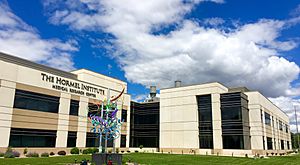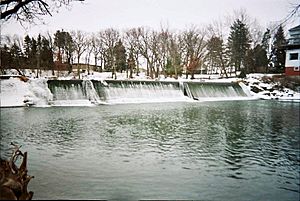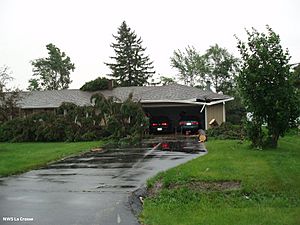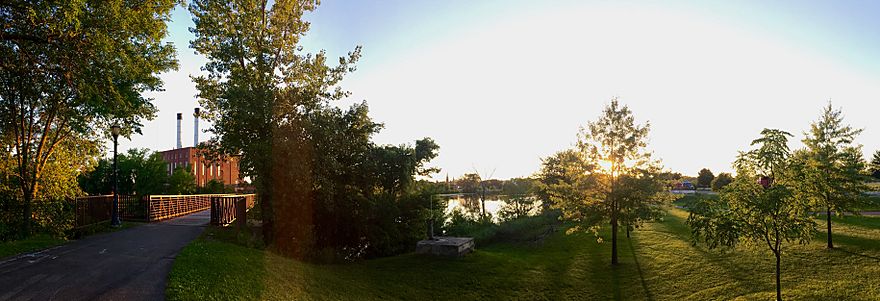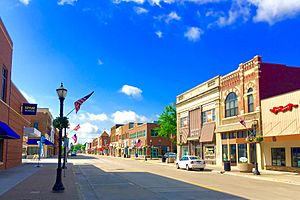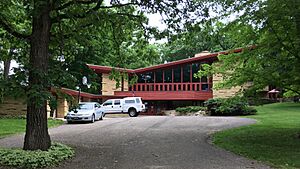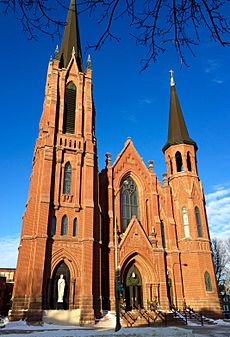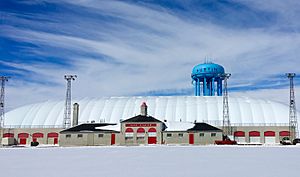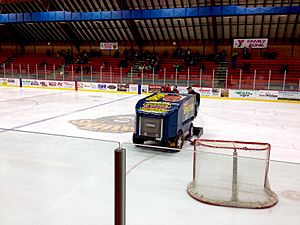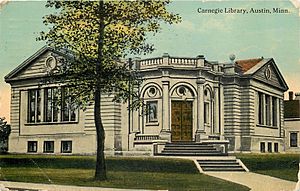Austin, Minnesota facts for kids
Quick facts for kids
Austin, Minnesota
|
||
|---|---|---|
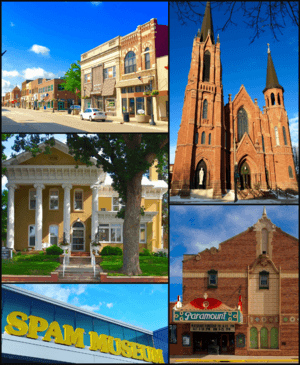
Clockwise from top: day city,ca St. Augustine's Church, Paramount Theater, Spam Museum, Hormel Historic Home
|
||
|
||
| Nickname(s):
SPAM Town USA
|
||
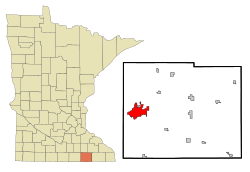
|
||
| Country | United States | |
| State | Minnesota | |
| County | Mower | |
| Platted | Spring of 1856 | |
| Incorporated as a village | March 6, 1868 | |
| Incorporated as a city | February 28, 1871 | |
| Area | ||
| • City | 13.39 sq mi (34.7 km2) | |
| • Land | 13.29 sq mi (34.4 km2) | |
| • Water | 0.11 sq mi (0.3 km2) | |
| Elevation | 1,211 ft (369 m) | |
| Population
(2020)
|
||
| • City | 26,174 | |
| • Estimate
(2022)
|
26,208 | |
| • Density | 1,972.45/sq mi (761.57/km2) | |
| • Urban | 25,479 | |
| • Metro | 40,140 (US: 315th) | |
| Time zone | UTC-6 (Central (CST)) | |
| • Summer (DST) | UTC-5 (CDT) | |
| ZIP code |
55912
|
|
| Area code(s) | 507 | |
| FIPS code | 27-02908 | |
| GNIS | 2394037 | |
Austin is a city in Minnesota, located in Mower County. About 26,000 people live here. The city was built along the Cedar River. It also has two man-made lakes, East Side Lake and Mill Pond. Austin is named after Austin R. Nichols, who was the first European settler in the area.
Austin is often called "SPAM Town USA." This is because Hormel Foods Corporation has its main office and a large factory here. This factory makes most of the SPAM canned meat for North America. You can even visit the Spam Museum in Austin! The city is also home to the Hormel Institute, a top cancer research center. It is supported by the University of Minnesota and the Mayo Clinic.
Contents
History of Austin
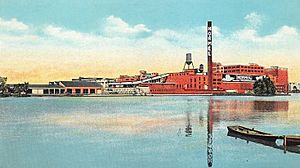
Austin's rich land and easy river access first attracted trappers. Then, early pioneers came to settle here. Austin Nichols, a trapper, built the first log cabin in 1853. By 1856, enough people lived in the area to form Mower County. The settlement was named "Austin" to honor its first settler. That same year, the first hotel opened, and the first doctor moved to town. The first newspaper, the Mower County Mirror, started in 1858.
Mills, powered by the Cedar River, were Austin's first businesses. They made flour and lumber. Growth was slow at first. However, the Chicago, Milwaukee, and St. Paul Railroad arrived in the late 1860s. This helped the city grow faster. Austin's first schoolhouse was built in 1865, and the first bank opened in 1866.
In 1891, George A. Hormel started a small butcher shop in Austin. This shop grew into the big company we know today as Hormel Foods. By 1896, local doctors and churches started the Austin Hospital Association. This later became part of the Mayo Clinic Health System.
In 1897, Charles Boostrom opened Austin's first college. It was called the Southern Minnesota Normal College. This college closed in 1925. Austin did not have another college until Austin Junior College opened in 1940. Today, it is known as Riverland Community College.
In 1913, a piece of land became Horace Austin State Park. This park was later given to the city in 1949. In the 1930s, Austin Acres was built to provide homes. The Austin Parks Board was created in the 1940s to manage the city's growing green spaces.
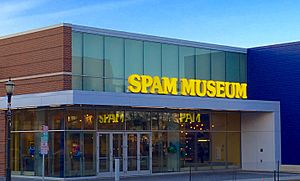
In 1971, the Jay C. Hormel Nature Center was created. It is a large nature preserve. In 1973, the city opened Riverside Arena, its first indoor ice rink. It is now home to the Austin Bruins junior hockey team.
In 1985, many Hormel meatpackers went on strike. This was a long and difficult time for the city. The strike lasted for 10 months. The governor even called in the National Guard to help keep the peace. A documentary film called American Dream was made about this strike. It won an Oscar in 1990.
Austin in the 21st Century
Austin built a new courthouse and jail in 2010. A new intermediate school was completed in 2013. The city is also working on a big project called Vision 2020. This plan aims to improve the community by 2020. It includes projects for jobs, health, education, and tourism. A new community recreation center is being built. The Spam Museum also moved to Main Street in 2016. This helps make downtown a fun place to visit.
In 2015, Austin was named one of the "Top 10 Affordable Small Towns Where You'd Actually Want to Live." This was by the National Association of Realtors.
Major Floods in Austin
Austin has often experienced flooding. The Cedar River, Dobbins Creek, and Turtle Creek flow through the city. Many buildings were built in areas that can flood. After big floods in 1978 and 2010, Austin started a major flood protection program. This involved buying and tearing down buildings in flood-prone areas. These areas were then turned into parks. A flood wall was also built to protect the downtown area.
The worst flood on record happened in 2000. The Cedar River reached 23.4 feet high. More flooding happened in 2004, causing two deaths. More dikes were added along the Cedar River after this. The most recent serious flooding was in 2010. A permanent flood wall was then completed in 2014. This wall protects downtown from the river.
Major Tornadoes in Austin
Austin has also seen several tornadoes. On August 20, 1928, an F-2 tornado hit the city. It damaged many buildings, including St. Olaf Lutheran Church and the Carnegie Library. People even saw straw and laundry falling from the sky!
Another F-2 tornado touched down in August 1961. It became an F-3 and destroyed a garage. It also hit the grandstand roof at the city fairgrounds. In 1984, a tornado destroyed Echo Lanes Bowling Alley.
On June 17, 2009, an EF2 tornado moved across the northwest part of Austin. It caused damage at the Jay C. Hormel Nature Center. About 300 trees were lost there. Only a few minor injuries were reported.
Geography of Austin
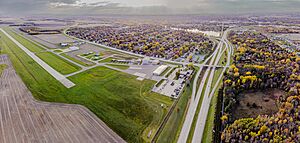
Austin is in southeastern Minnesota, in Mower County. It is about 20 miles east of Albert Lea and 41 miles southwest of Rochester. The city is about 100 miles south of Minneapolis. It is also only 12 miles north of the Iowa border.
Austin covers about 13.39 square miles. Most of this is land, with a small amount of water. The city's elevation is about 1,200 feet. The Cedar River flows through the east side of the city. Other smaller streams, like Turtle Creek and Dobbins Creek, also flow through Austin.
Austin's Climate
Austin has a humid continental climate. This means winters are cold and snowy. Summers are warm with some humidity. The weather in Austin is typical for the Upper Midwest.
| Climate data for Austin, Minnesota (1991–2020 normals, extremes 1938–present) | |||||||||||||
|---|---|---|---|---|---|---|---|---|---|---|---|---|---|
| Month | Jan | Feb | Mar | Apr | May | Jun | Jul | Aug | Sep | Oct | Nov | Dec | Year |
| Record high °F (°C) | 62 (17) |
71 (22) |
80 (27) |
91 (33) |
100 (38) |
100 (38) |
102 (39) |
101 (38) |
97 (36) |
92 (33) |
79 (26) |
65 (18) |
102 (39) |
| Mean maximum °F (°C) | 40.9 (4.9) |
45.0 (7.2) |
63.8 (17.7) |
79.1 (26.2) |
86.8 (30.4) |
91.4 (33.0) |
90.5 (32.5) |
88.7 (31.5) |
87.0 (30.6) |
80.8 (27.1) |
63.0 (17.2) |
45.8 (7.7) |
93.6 (34.2) |
| Mean daily maximum °F (°C) | 21.9 (−5.6) |
26.4 (−3.1) |
39.2 (4.0) |
54.9 (12.7) |
67.5 (19.7) |
77.6 (25.3) |
80.8 (27.1) |
78.7 (25.9) |
72.2 (22.3) |
58.3 (14.6) |
41.5 (5.3) |
27.9 (−2.3) |
53.9 (12.2) |
| Daily mean °F (°C) | 13.7 (−10.2) |
17.8 (−7.9) |
31.0 (−0.6) |
45.0 (7.2) |
57.5 (14.2) |
67.9 (19.9) |
71.0 (21.7) |
68.7 (20.4) |
61.1 (16.2) |
47.9 (8.8) |
33.1 (0.6) |
20.5 (−6.4) |
44.6 (7.0) |
| Mean daily minimum °F (°C) | 5.4 (−14.8) |
9.1 (−12.7) |
22.7 (−5.2) |
35.2 (1.8) |
47.5 (8.6) |
58.2 (14.6) |
61.2 (16.2) |
58.7 (14.8) |
50.0 (10.0) |
37.5 (3.1) |
24.7 (−4.1) |
13.0 (−10.6) |
35.3 (1.8) |
| Mean minimum °F (°C) | −18.6 (−28.1) |
−13.2 (−25.1) |
−1.5 (−18.6) |
19.2 (−7.1) |
31.9 (−0.1) |
44.9 (7.2) |
49.4 (9.7) |
46.7 (8.2) |
33.3 (0.7) |
20.9 (−6.2) |
6.2 (−14.3) |
−10.2 (−23.4) |
−21.4 (−29.7) |
| Record low °F (°C) | −42 (−41) |
−34 (−37) |
−34 (−37) |
5 (−15) |
22 (−6) |
31 (−1) |
41 (5) |
34 (1) |
20 (−7) |
10 (−12) |
−25 (−32) |
−33 (−36) |
−42 (−41) |
| Average precipitation inches (mm) | 1.12 (28) |
1.10 (28) |
2.03 (52) |
3.67 (93) |
4.99 (127) |
5.07 (129) |
4.85 (123) |
4.07 (103) |
3.60 (91) |
2.63 (67) |
1.84 (47) |
1.25 (32) |
36.22 (920) |
| Average snowfall inches (cm) | 11.0 (28) |
10.4 (26) |
7.5 (19) |
2.2 (5.6) |
0.3 (0.76) |
0.0 (0.0) |
0.0 (0.0) |
0.0 (0.0) |
0.0 (0.0) |
0.4 (1.0) |
2.3 (5.8) |
9.3 (24) |
43.4 (110) |
| Average extreme snow depth inches (cm) | 9.5 (24) |
12.5 (32) |
10.0 (25) |
1.6 (4.1) |
0.3 (0.76) |
0.0 (0.0) |
0.0 (0.0) |
0.0 (0.0) |
0.0 (0.0) |
0.0 (0.0) |
1.5 (3.8) |
8.2 (21) |
16.3 (41) |
| Average precipitation days (≥ 0.01 in) | 5.9 | 5.3 | 7.1 | 10.9 | 13.0 | 11.7 | 10.7 | 10.3 | 9.3 | 9.4 | 6.1 | 6.6 | 106.3 |
| Average snowy days (≥ 0.1 in) | 6.4 | 5.5 | 3.5 | 1.2 | 0.1 | 0.0 | 0.0 | 0.0 | 0.0 | 0.4 | 2.5 | 6.0 | 25.6 |
| Source: NOAA | |||||||||||||
People of Austin
| Historical population | |||
|---|---|---|---|
| Census | Pop. | %± | |
| 1860 | 200 | — | |
| 1870 | 2,039 | 919.5% | |
| 1880 | 2,305 | 13.0% | |
| 1890 | 3,901 | 69.2% | |
| 1900 | 5,474 | 40.3% | |
| 1910 | 6,960 | 27.1% | |
| 1920 | 10,118 | 45.4% | |
| 1930 | 12,276 | 21.3% | |
| 1940 | 18,307 | 49.1% | |
| 1950 | 23,100 | 26.2% | |
| 1960 | 27,908 | 20.8% | |
| 1970 | 25,074 | −10.2% | |
| 1980 | 23,020 | −8.2% | |
| 1990 | 21,907 | −4.8% | |
| 2000 | 23,314 | 6.4% | |
| 2010 | 24,718 | 6.0% | |
| 2020 | 26,174 | 5.9% | |
| 2022 (est.) | 26,208 | 6.0% | |
| U.S. Decennial Census 2020 Census |
|||
As of 2020, Austin had 26,174 people living in the city. There were 10,980 households. In 2010, about 86.8% of the people were White. About 15.4% of the population was Hispanic or Latino. The average age in Austin was 37 years old. About 25.6% of residents were under 18.
Austin's Economy
Hormel's main office and factory are in Austin. This means food processing is a very important part of the city's economy. Hormel and Quality Pork Processors are Austin's biggest private employers. Besides SPAM, Hormel makes many other foods. These include Jennie-O turkey, Muscle Milk, Skippy peanut butter, and Dinty Moore beef stew.
Other important jobs in Austin are in government, education, hotels, and retail. Because Hormel keeps growing, Austin usually has low unemployment rates. In February 2016, the unemployment rate was 3.7%. This was lower than the state and national averages.
Austin's retail businesses had a tough time during the Great Recession. However, things have improved since then. The former Oak Park Mall site is being redeveloped. The new SPAM Museum also opened downtown in 2016.
Top Employers in Austin
Here are the top employers in Austin, based on a 2022 report:
| # | Employer | # of Employees |
|---|---|---|
| 1 | Hormel Foods | 3,255 |
| 2 | Quality Pork Processors | 1,225 |
| 3 | Mayo Clinic Health System | 900 |
| 4 | Austin Public Schools ISD No. 492 | 850 |
| 5 | Walmart | 325 |
| 6 | Hy-Vee | 300 |
| 7 | Mower County | 274 |
| 8 | Riverland Community College | 240 |
| 9 | City of Austin | 219 |
| 10 | Cedar Valley Services | 192 |
Arts and Culture in Austin

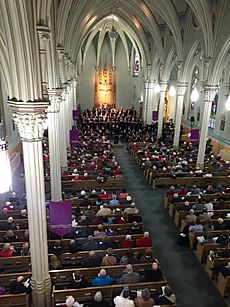
Austin has many long-standing arts groups. The Austin Symphony Orchestra started in 1957. The Austin Artist Series, a major concert series, began in 1945. The Historic Paramount Theatre hosts many local and regional shows. Austin High School's music programs are also well-known. Austin also has community choirs and bands. Many professional musicians have come from Austin. These include John Maus, Trace Bundy, and Charlie Parr.
In 2015, the MacPhail Center for Music opened a location in Austin. It offers music lessons for all ages.
Theater in Austin
The Frank W. Bridges Theatre at Riverland Community College has an active theater program. Matchbox Children's Theatre, started in 1975, puts on shows all year. Summerset Theatre, a community theater group, also presents several shows each year.
Austin ArtWorks Center
The Austin ArtWorks Center opened in 2014. It has art exhibits, classes, and a shop. It is run by the Austin Area Commission for the Arts. This group also organizes the Austin ArtWorks Festival every year. The center is in the historic First National Bank Building.
Austin's Architecture
Austin has many important historic buildings. These include Austin High School and St. Augustine's Church. The Historic Paramount Theatre and the Hormel Historic Home are also notable.
The S. P. Elam Residence (1950) was designed by famous architect Frank Lloyd Wright. It is a large example of his Usonian style.
Literature in Austin
Austin is the setting for Allen Eskens' novel The Life We Bury. This book was published in 2014.
Places to Visit in Austin
- Mower County Fairgrounds and Mower County Fair
- Buffy the Cow
- SPAM Museum
- Jay C. Hormel Nature Center
- Hormel Historic Home
- St. Augustine's Church
- Austin ArtWorks Center
- Austin High School and Knowlton Auditorium
- Mower County Historical Society
- Historic Paramount Theatre
- Sola Fide Observatory
- East Side Lake
- Bandshell Community Park
- Todd Park
- Austin Country Club (private)
- Meadow Greens Golf Course (public)
- The Elam House (Frank Lloyd Wright home)
- Christ Episcopal Church
- Packer Dome (seasonal)
- Vintage Bicycle Collection at Rydjor Bike Shop
- Hormel Institute
- Roosevelt Bridge
Sports in Austin
The Austin Bruins are a North American Hockey League team. They started playing in 2010. The Bruins play their home games at Riverside Arena. Austin also has two amateur baseball teams, the Austin Blue Sox and Austin Greyhounds. Riverland Community College has six college sports teams.
Other sports groups in Austin include the Southern Minnesota Bicycling Club and the Austin Curling Club.
Riverside Arena
The Riverside Arena is a large indoor stadium. It opened in 1973 and can seat 2,500 people. It is home to the Austin High School Packers hockey teams. The Austin Bruins also play here.
In 2010, the arena got new lighting and a Jumbotron screen. In 2015, the ice rink was completely updated.
Packer Dome
Packer Dome is a seasonal sports facility. It was built in 2015. It provides space for sports and recreation in Austin. The Hormel Foundation helped fund this project.
Parks and Recreation in Austin
Austin has many parks and green spaces. There are 28 parks managed by the city. These range from small quiet parks to the large Jay C. Hormel Nature Center.
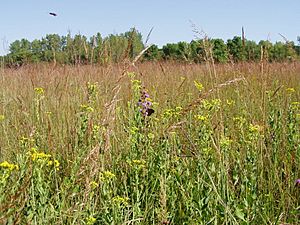
Jay C. Hormel Nature Center
The Hormel Nature Center opened in 1971. It is located within Austin's city limits. It has prairies, forests, wetlands, and streams. There are over ten miles of trails for visitors. You can see deer, mink, raccoons, and many birds. The Interpretive Center has hands-on exhibits and live animals. You can also rent canoes, kayaks, skis, and snowshoes here.
Other Parks in Austin
Horace Austin Park is in downtown Austin. It has playgrounds, a public pool, and trails around Mill Pond. Austin has parks in all parts of the city. Many are connected by a trail system. These include Bandshell Community Park, Driesner Park, and Todd Park. Todd Park is popular in summer. It has sand volleyball courts and many softball and baseball fields.
Bandshell Community Park hosts Austin's yearly Independence Day celebration. Thousands of people come for music, carnival games, and fireworks.
Education in Austin
Austin Public Schools serves over 4,700 students. Pacelli Catholic Schools also offers private education from PreK to 12th grade. Austin High School is known for its unique architecture. It has a large auditorium called Knowlton Auditorium. It seats 1,850 people. For college, students can attend Riverland Community College. It started as Austin Junior College in 1940.
- Colleges
- Riverland Community College
- Maranatha Bible School (Lansing)
- High Schools
- Austin High School and Area Learning Center (Grades 9–12)
- Pacelli High School (Grades 9–12)
- Middle Schools (Junior High)
- Ellis Middle School [Grades 7–8]
- I.J Holton Intermediate School [Grades 5–6]
- Pacelli Middle School (Grades 6–8)
- Elementary Schools
- Pacelli Elementary School (Grades PreK-5)
- Banfield Elementary School (Grades 1–4)
- Neveln Elementary School (Grades 1–4)
- Southgate Elementary School (Grades 1–4)
- Sumner Elementary School (Grades 1–4)
- Woodson School (Kindergarten only)
- Oakland Education Center (special services coop with Albert Lea Public Schools; formerly St. Edward's School)
- Other schools
- Austin Area Catholic Schools
- Gerard Academy (ages 6–19)
- Oakland Baptist School
- Former school buildings
- Franklin School (original built in 1869, burned in 1890; new Franklin High School opened in 1891)
- Shaw Elementary School (opened, 1916; last year of operation, 1992; demolished, 1993)
- Webster School (Built in 1891, functions today as apartment homes)
- Lincoln Elementary School (Built in 1887; last year of operation, 1977); functions today as apartment homes)
- Queen of Angels School (now home to Community Learning Center and Early Childhood Family Education Center)
Austin Public Library
The Austin Public Library first opened in 1884. In 1904, the city opened a new Carnegie Library building. This building was torn down in 1996. A new library was then opened at 323 4th Ave. NE. It has over 80,000 books.
Media in Austin
Radio Stations
| AM radio stations | ||||
|---|---|---|---|---|
| Frequency | Call sign | Name | Format | |
| 970 | KQAQ | Real Presence Radio | Catholic | |
| 1450 | KATE | News/Talk | ||
| 1480 | KAUS | News/Talk | ||
| FM radio stations | ||||
|---|---|---|---|---|
| Frequency | Call sign | Name | Format | |
| 88.5 | KBDC | American Family Radio | Christian | |
| 90.1 | KNSE | MPR News | NPR | |
| 91.3 | KMSK | The Maverick | Public radio | |
| 96.1 | KQPR | Power 96 | Classic hits | |
| 99.9 | KAUS | US Country 99.9 | Country | |
| 102.7 | KYTC | Super Hits 102.7 | Classic Hits | |
| 103.3 | K233AD (KLSE Translator) |
Classical MPR | Classical | |
| 103.9 | K280EF (KCMP Translator) |
The Current | AAA | |
| 104.3 | KFNL-FM | Fun 104.3 | Classic hits | |
| 105.3 | KYBA | Y105 | AC | |
| 106.9 | KROC | CHR | ||
Television Stations
Austin has two TV studios: KAAL channel 6 (ABC) and KSMQ-TV channel 15 (PBS). Other nearby stations include those from Rochester and Mason City, Iowa.
| Channel | Callsign | Affiliation | Branding | Subchannels | |
|---|---|---|---|---|---|
| (Virtual) | Channel | Programming | |||
| 3.1 | KIMT | CBS | KIMT 3 | 3.2 3.3 3.4 |
MyNetworkTV ION Antenna TV |
| 6.1 | KAAL | ABC | KAAL 6 | 6.2 | Start TV
Ion Plus Bounce TV ION |
| 10.1 | KTTC | NBC | KTTC 10 | 10.2 10.3 10.4 10.5 10.6 |
CW+ Heroes & Icons Court TV True Crime Network Outlaw |
| 15.1 | KSMQ | PBS | KSMQ | 15.2 15.3 15.4 |
Deutsche Welle Create Minnesota Channel |
| 24.1 | KYIN | PBS | Iowa PBS | 24.2 24.3 24.4 |
PBS Kids World Create |
| 47.1 | KXLT | FOX | FOX 47 | 47.2 47.3 47.4 47.5 47.6 47.7 |
MeTV
MeTV Toons |
Newspapers and Films
The Austin Daily Herald is a daily newspaper for the community. Austin Living is a magazine about Austin's culture and lifestyle. The Post-Bulletin from Rochester is also read in Austin.
The film American Dream was filmed in Austin. It was about the 1985–86 Hormel strike.
Transportation in Austin

Airports Near Austin
Austin has its own airport, Austin Municipal Airport. For bigger flights, the nearest international airports are in Rochester (RST) and Minneapolis (MSP).
Bus and Public Transit
Southern Minnesota Area Rural Transit (SMART) provides bus service within Austin and Mower County. Rochester City Lines offers daily bus trips between Austin and Rochester. Taxi service is also available in the city.
Major Roads in Austin
Austin is located where Interstate 90 and U.S. Route 218 meet. Minnesota State Highway 105 also runs south from Austin to Iowa.
 Interstate 90 goes east-west through the north side of the city.
Interstate 90 goes east-west through the north side of the city. U.S. Route 218 passes through the east side of the city.
U.S. Route 218 passes through the east side of the city. Minnesota State Highway 105 goes through the southern and western parts of the city.
Minnesota State Highway 105 goes through the southern and western parts of the city.
Railroads in Austin
Austin was once a big railroad town. Many train lines met here. Passenger train service to Austin ended in 1965. However, freight trains still use some of the old lines today.
Walking and Biking Trails
Austin has many paved trails for biking and hiking. There are miles of bike paths. These paths connect to Todd Park and the Jay C. Hormel Nature Center. A mountain biking trail was also finished in 2015.
These trails will connect Austin to other trails in the future. These include the Blazing Star Trail and the Shooting Star State Trail.
Notable People from Austin
- Marc Anderson, musician
- Josh Braaten, actor
- Philip Brunelle, conductor
- Trace Bundy, guitar player
- James W. Davidson, explorer and diplomat
- Richard Eberhart, United States Poet Laureate
- Shannon Frid-Rubin, violinist
- Jason Gerhardt, actor
- Jackie Graves, boxer
- Matthew Griswold, musician
- Burdette Haldorson, basketball player and Olympian
- Charles Robert Hansen, politician
- Vince Hanson, basketball player
- Amanda Hocking, writer
- Geordie Hormel, musician and composer
- George A. Hormel, founder of Hormel Foods
- James C. Hormel, ambassador
- Jay Catherwood Hormel, former president of Hormel Foods
- Craig Hutchinson, film director
- Hope Jahren, scientist
- Lee Janzen, professional golfer
- Molly Kate Kestner, musician
- Jennie Ellis Keysor, educator and writer
- Larry Kramer, football player and coach
- Tom Lehman, professional golfer
- John Madden, former NFL coach and commentator
- John Maus, musician
- Helen E. McMillan, state legislator
- Patrick Moore, professional golfer
- Wilbur Moore, professional football player
- Barry Morrow, screenwriter and producer
- Bob Motzko, ice hockey coach
- Tim O'Brien, novelist
- Charlie Parr, musician
- Pat Piper, politician
- Jeanne Poppe, state representative
- Leo J. Reding, politician
- William Pitt Root, poet
- Frank Twedell, professional football player
- Wally Ulrich, professional golfer
- Sheldon B. Vance, U.S. ambassador
- Bree Walker, radio host and actress
- Robert B. Westbrook, historian
- Sandy Wollschlager, chemist and state representative
- Michael Wuertz, former baseball player
- Martin Zellar, musician and songwriter
See also
 In Spanish: Austin (Minnesota) para niños
In Spanish: Austin (Minnesota) para niños




